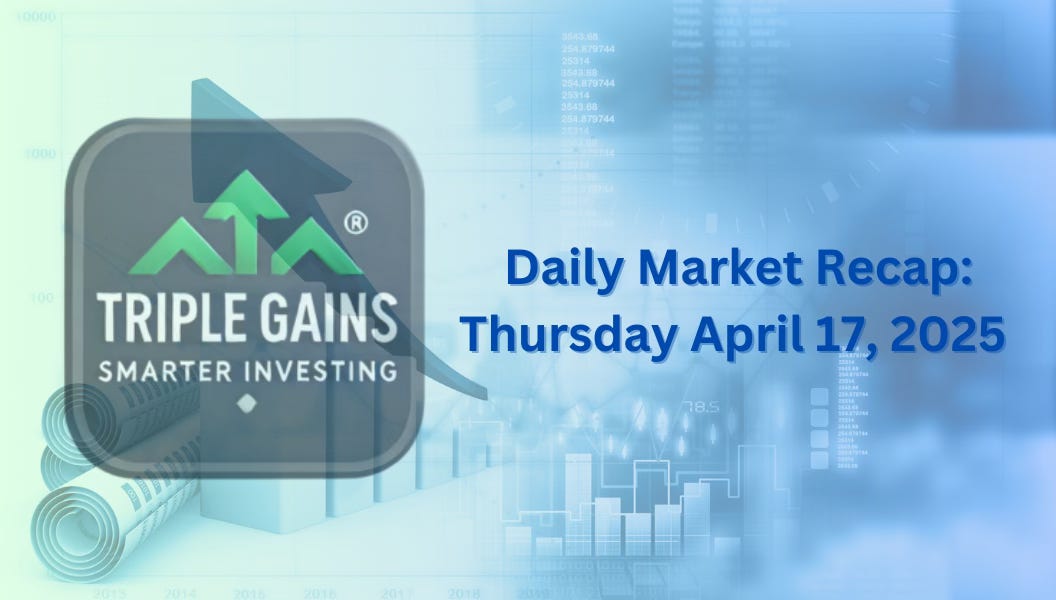Market Recap – Thursday, April 17, 2025
Mixed Market Close Amid Trade Uncertainty and Fed Concerns: Key Sectors Diverge
US equities finished the trading day mixed, with the Dow closing lower by 1.73%, the S&P 500 down by 0.17%, and the Nasdaq falling 0.13%. However, the Russell 2000 posted a modest gain of 0.11%. The mixed performance was driven by notable underperformance in big tech, with Nvidia (NVDA) and Alphabet (GOOGL) adding to their recent losses. Conversely, sectors such as pharma, energy, and utilities saw stronger performance, with Eli Lilly (LLY) standing out due to positive data on its GLP-1 drug.
Key Market Themes:
Tariff and Trade Talks: Trade and tariff concerns continue to dominate the market narrative. While there were reports of progress in US-Japan trade talks, uncertainty remains high regarding US-China relations, with escalating tensions over export restrictions, particularly impacting semiconductor companies like Nvidia. The trade uncertainties have led to some volatility in sectors with heavy exposure to global supply chains.
Fed Independence Concerns: President Trump has once again expressed dissatisfaction with Fed Chair Jerome Powell, heightening concerns about the independence of the Federal Reserve. Trump's public comments on Powell's potential removal have added a layer of political risk to the economic outlook, while Powell reiterated that the Fed remains well-positioned to address inflation concerns.
Economic Data: Initial jobless claims came in better than expected at 215K, while the March housing starts and Philadelphia Fed index disappointed. Housing starts came in at 1.32 million, missing expectations, and the Philadelphia Fed index dropped sharply to -26.4, indicating a contraction in the manufacturing sector. The weaker-than-expected data adds to concerns about slowing economic growth.
Sector Performances:
Outperformers: Energy stocks, including WTI crude, saw a notable rally, rising 3.5%. Pharma and biotech stocks, particularly Eli Lilly (LLY), saw positive momentum following favorable trial data. The REIT sector and utilities also performed well, supported by steady demand for their services.
Underperformers: Technology stocks, especially in the semiconductor space, were significant underperformers, with Nvidia and Advanced Micro Devices (AMD) facing headwinds from the new export restrictions. Additionally, managed care, biotech, and semiconductors faced a tough day due to regulatory concerns and weak earnings reports.
Key Earnings Highlights:
Earnings Misses: UnitedHealth Group (UNH) missed earnings expectations and lowered its full-year guidance, citing increased healthcare costs. ASML and Omnicom Group (OMC) also missed earnings, with ASML’s bookings coming in below expectations and Omnicom cutting its organic growth guidance due to macro uncertainties.
Earnings Beats: On the other hand, Goldman Sachs (GS) beat revenue estimates with strong equities trading, and Eli Lilly (LLY) surged after releasing positive clinical data for its oral GLP-1 treatment. The market also reacted positively to positive guidance from Fidelity National Information Services (FIS).
Here’s Our Take
In the current environment of heightened uncertainty due to tariffs, regulatory concerns, and macroeconomic data pointing to slower growth, investors should approach the market with caution. The mixed performance across sectors highlights the risk of further volatility, particularly in tech and trade-sensitive stocks. The continued uncertainty surrounding US-China relations and the potential impact of tariffs on corporate earnings adds risk to portfolios.
For investors in balanced portfolios, maintaining a diversified approach is crucial. Allocations to defensive sectors like utilities, healthcare, and energy, which have shown resilience, may offer some protection in the near term. Meanwhile, commodities and real estate may provide attractive alternatives in the alternatives bucket, offering a hedge against inflation and market volatility. Focus should also be placed on short-duration fixed income to mitigate interest rate risk and potential bond market fluctuations. As always, remaining nimble and monitoring the evolving trade and macroeconomic landscape will be key to navigating these turbulent market conditions.



